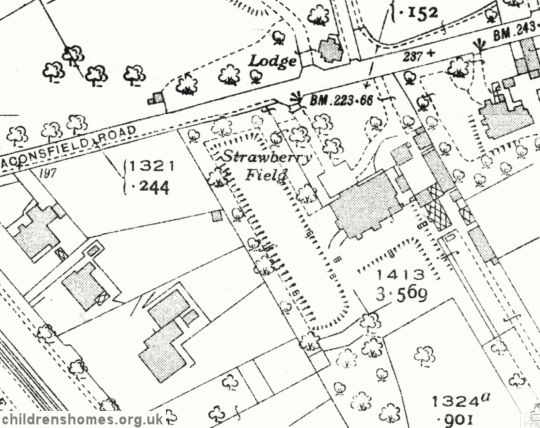Strawberry Field, Liverpool, Lancashire
In 1934, the Salvation Army acquired Strawberry Field, a Victorian mansion and its extensive grounds on Beaconsfield Road. Woolton, Liverpool, for use as a children's home. It was formally opened on 7 July 1936 by Lady Bates in the presence of General Evangeline Booth, daughter of the Salvation Army's founder, William Booth. Initially, accommodation was provided for up to forty girls. From the 1950s, boys up to five years old were also received, with older boys subsequently being admitted.
The home's site is shown on the 1936 map below.

Strawberry Field site, Liverpool, c.1936.
In 1973, serious deterioration of the fabric of the old house led to its demolition and replacement by a new building consisting of three family units, each with 12 children. At the same time, a new entrance drive was created further to the west along Beaconsfield Road and old gates and the pillars bearing the name Strawberry Field were no longer used.
The children's home finally closed in 2005 and the building was then used as a Salvation Army church and prayer centre. In 2019 the site was being redeveloped to include a training centre for young people with special educational needs.
The home attracted considerable attention after the Beatles released their recording of John Lennon's song Strawberry Fields Forever in 1967. The old gates on Beaconsfield Road subsequently became a point of pilgrimage for Beatles' fans and their condition suffered as a result. In 2011, the gates and pillars were replaced by a replica, with the originals being put into storage until 2017 when they went on display at the Beatles' Story at Liverpool's Albert Dock. They will return to form part of a special display at the Beaconsfield Road site once its redevelopment has been completed.

Strawberry Field Orphanage Gates, Liverpool. © Peter Higginbotham
Records
Note: many repositories impose a closure period of up to 100 years for records identifying individuals. Before travelling a long distance, always check that the records you want to consult will be available.
- The Salvation Army International Heritage Centre, William Booth College, Denmark Hill, London SE5 8BQ. Email heritage@salvationarmy.org.uk. Has a research service, with initial enquiries answered free, more detailed follow-up research charged at £20 per hour. There is also an online catalogue of the Centre's holdings.
Bibliography
- Booth, William In Darkest England, and the Way Out (1890, London: International Headquarters of the Salvation Army)
- Sandall, Robert The History of the Salvation Army (1955, London: Nelson)
Links
- The Salvation Army (UK)
- The Salvation Army — an illustrated history by Peter Higginbotham.
Except where indicated, this page () © Peter Higginbotham. Contents may not be reproduced without permission.


